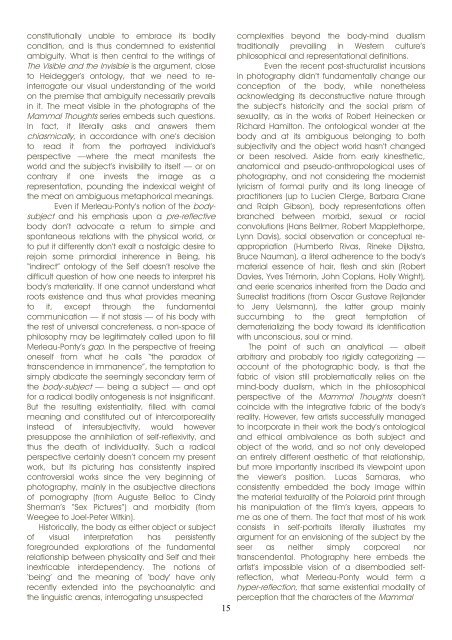Meet Animal Meat - Antennae The Journal of Nature in Visual Culture
Meet Animal Meat - Antennae The Journal of Nature in Visual Culture
Meet Animal Meat - Antennae The Journal of Nature in Visual Culture
Create successful ePaper yourself
Turn your PDF publications into a flip-book with our unique Google optimized e-Paper software.
constitutionally unable to embrace its bodily<br />
condition, and is thus condemned to existential<br />
ambiguity. What is then central to the writ<strong>in</strong>gs <strong>of</strong><br />
<strong>The</strong> Visible and the Invisible is the argument, close<br />
to Heidegger’s ontology, that we need to re<strong>in</strong>terrogate<br />
our visual understand<strong>in</strong>g <strong>of</strong> the world<br />
on the premise that ambiguity necessarily prevails<br />
<strong>in</strong> it. <strong>The</strong> meat visible <strong>in</strong> the photographs <strong>of</strong> the<br />
Mammal Thoughts series embeds such questions.<br />
In fact, it literally asks and answers them<br />
chiasmically, <strong>in</strong> accordance with one’s decision<br />
to read it from the portrayed <strong>in</strong>dividual’s<br />
perspective —where the meat manifests the<br />
world and the subject’s <strong>in</strong>visibility to itself — or on<br />
contrary if one <strong>in</strong>vests the image as a<br />
representation, pound<strong>in</strong>g the <strong>in</strong>dexical weight <strong>of</strong><br />
the meat on ambiguous metaphorical mean<strong>in</strong>gs.<br />
Even if Merleau-Ponty’s notion <strong>of</strong> the bodysubject<br />
and his emphasis upon a pre-reflective<br />
body don’t advocate a return to simple and<br />
spontaneous relations with the physical world, or<br />
to put it differently don’t exalt a nostalgic desire to<br />
rejo<strong>in</strong> some primordial <strong>in</strong>herence <strong>in</strong> Be<strong>in</strong>g, his<br />
“<strong>in</strong>direct” ontology <strong>of</strong> the Self doesn’t resolve the<br />
difficult question <strong>of</strong> how one needs to <strong>in</strong>terpret his<br />
body’s materiality. If one cannot understand what<br />
roots existence and thus what provides mean<strong>in</strong>g<br />
to it, except through the fundamental<br />
communication — if not stasis — <strong>of</strong> his body with<br />
the rest <strong>of</strong> universal concreteness, a non-space <strong>of</strong><br />
philosophy may be legitimately called upon to fill<br />
Merleau-Ponty’s gap. In the perspective <strong>of</strong> free<strong>in</strong>g<br />
oneself from what he calls “the paradox <strong>of</strong><br />
transcendence <strong>in</strong> immanence”, the temptation to<br />
simply abdicate the seem<strong>in</strong>gly secondary term <strong>of</strong><br />
the body-subject — be<strong>in</strong>g a subject — and opt<br />
for a radical bodily ontogenesis is not <strong>in</strong>significant.<br />
But the result<strong>in</strong>g existentiality, filled with carnal<br />
mean<strong>in</strong>g and constituted out <strong>of</strong> <strong>in</strong>tercorporeality<br />
<strong>in</strong>stead <strong>of</strong> <strong>in</strong>tersubjectivity, would however<br />
presuppose the annihilation <strong>of</strong> self-reflexivity, and<br />
thus the death <strong>of</strong> <strong>in</strong>dividuality. Such a radical<br />
perspective certa<strong>in</strong>ly doesn’t concern my present<br />
work, but its pictur<strong>in</strong>g has consistently <strong>in</strong>spired<br />
controversial works s<strong>in</strong>ce the very beg<strong>in</strong>n<strong>in</strong>g <strong>of</strong><br />
photography, ma<strong>in</strong>ly <strong>in</strong> the asubjective directions<br />
<strong>of</strong> pornography (from Auguste Belloc to C<strong>in</strong>dy<br />
Sherman’s “Sex Pictures”) and morbidity (from<br />
Weegee to Joel-Peter Witk<strong>in</strong>).<br />
Historically, the body as either object or subject<br />
<strong>of</strong> visual <strong>in</strong>terpretation has persistently<br />
foregrounded explorations <strong>of</strong> the fundamental<br />
relationship between physicality and Self and their<br />
<strong>in</strong>extricable <strong>in</strong>terdependency. <strong>The</strong> notions <strong>of</strong><br />
‘be<strong>in</strong>g’ and the mean<strong>in</strong>g <strong>of</strong> ‘body’ have only<br />
recently extended <strong>in</strong>to the psychoanalytic and<br />
the l<strong>in</strong>guistic arenas, <strong>in</strong>terrogat<strong>in</strong>g unsuspected<br />
15<br />
complexities beyond the body-m<strong>in</strong>d dualism<br />
traditionally prevail<strong>in</strong>g <strong>in</strong> Western culture’s<br />
philosophical and representational def<strong>in</strong>itions.<br />
Even the recent post-structuralist <strong>in</strong>cursions<br />
<strong>in</strong> photography didn’t fundamentally change our<br />
conception <strong>of</strong> the body, while nonetheless<br />
acknowledg<strong>in</strong>g its deconstructive nature through<br />
the subject’s historicity and the social prism <strong>of</strong><br />
sexuality, as <strong>in</strong> the works <strong>of</strong> Robert He<strong>in</strong>ecken or<br />
Richard Hamilton. <strong>The</strong> ontological wonder at the<br />
body and at its ambiguous belong<strong>in</strong>g to both<br />
subjectivity and the object world hasn’t changed<br />
or been resolved. Aside from early k<strong>in</strong>esthetic,<br />
anatomical and pseudo-anthropological uses <strong>of</strong><br />
photography, and not consider<strong>in</strong>g the modernist<br />
lyricism <strong>of</strong> formal purity and its long l<strong>in</strong>eage <strong>of</strong><br />
practitioners (up to Lucien Clerge, Barbara Crane<br />
and Ralph Gibson), body representations <strong>of</strong>ten<br />
branched between morbid, sexual or racial<br />
convolutions (Hans Bellmer, Robert Mapplethorpe,<br />
Lynn Davis), social observation or conceptual reappropriation<br />
(Humberto Rivas, R<strong>in</strong>eke Dijkstra,<br />
Bruce Nauman), a literal adherence to the body’s<br />
material essence <strong>of</strong> hair, flesh and sk<strong>in</strong> (Robert<br />
Davies, Yves Trémor<strong>in</strong>, John Coplans, Holly Wright),<br />
and eerie scenarios <strong>in</strong>herited from the Dada and<br />
Surrealist traditions (from Oscar Gustave Rejlander<br />
to Jerry Uelsmann), the latter group ma<strong>in</strong>ly<br />
succumb<strong>in</strong>g to the great temptation <strong>of</strong><br />
dematerializ<strong>in</strong>g the body toward its identification<br />
with unconscious, soul or m<strong>in</strong>d.<br />
<strong>The</strong> po<strong>in</strong>t <strong>of</strong> such an analytical — albeit<br />
arbitrary and probably too rigidly categoriz<strong>in</strong>g —<br />
account <strong>of</strong> the photographic body, is that the<br />
fabric <strong>of</strong> vision still problematically relies on the<br />
m<strong>in</strong>d-body dualism, which <strong>in</strong> the philosophical<br />
perspective <strong>of</strong> the Mammal Thoughts doesn’t<br />
co<strong>in</strong>cide with the <strong>in</strong>tegrative fabric <strong>of</strong> the body’s<br />
reality. However, few artists successfully managed<br />
to <strong>in</strong>corporate <strong>in</strong> their work the body’s ontological<br />
and ethical ambivalence as both subject and<br />
object <strong>of</strong> the world, and so not only developed<br />
an entirely different aesthetic <strong>of</strong> that relationship,<br />
but more importantly <strong>in</strong>scribed its viewpo<strong>in</strong>t upon<br />
the viewer’s position. Lucas Samaras, who<br />
consistently embedded the body image with<strong>in</strong><br />
the material texturality <strong>of</strong> the Polaroid pr<strong>in</strong>t through<br />
his manipulation <strong>of</strong> the film’s layers, appears to<br />
me as one <strong>of</strong> them. <strong>The</strong> fact that most <strong>of</strong> his work<br />
consists <strong>in</strong> self-portraits literally illustrates my<br />
argument for an envision<strong>in</strong>g <strong>of</strong> the subject by the<br />
seer as neither simply corporeal nor<br />
transcendental. Photography here embeds the<br />
artist’s impossible vision <strong>of</strong> a disembodied selfreflection,<br />
what Merleau-Ponty would term a<br />
hyper-reflection, that same existential modality <strong>of</strong><br />
perception that the characters <strong>of</strong> the Mammal












